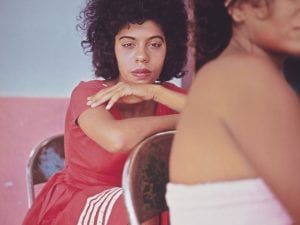It may be the inaugural exhibition for the Whitney Museum Of American Art’s spectacular new Renzo Piano-designed building, but it is the Whitney’s collection which takes centre stage here, rather than being overshadowed by the architecture. Taking its title from a line in a Robert Frost poem, America Is Hard To See considers more than a century of modern American art in its social and political context.
The exhibition aims to avoid categorising works as part of a narrative about the development of a particular artistic movement or style. Instead, pieces are organised both chronologically and under 23 thematic “chapters”, meaning that works in all media feature alongside each other, acknowledging the ways in which artists have torn down the barriers between the creative disciplines. Indeed, the title also refers to a film by the political documentary-maker Emile de Antonio, who associated with, influenced and was influenced by the likes of Andy Warhol, Jasper Johns and Robert Rauschenberg. These themed sections revisit and revise established tropes while forging new categories and expanding the definition of who counts as an American artist. Each chapter takes its name from the title of a keynote work, with headings like Scotch Tape, Raw War and Rational Irrationalism, leading to an exhibition of unexpected juxtapositions and surprising coincidences.
Re-examining the history of art in the US from the beginning of the 20th century to the present, more than 600 works ranging from the well-known and iconic to the rarely-seen, demonstrate the ever- shifting perspectives of American artists on a vast, complex and diverse culture that, as Frost’s line suggests, will always defy easy definition. Among the highlights is a striking display of abstract expressionism, including the likes of Lee Krasner and Willem de Kooning, Other sections address some of the political issues that over the last century have led the US to question itself and its role in the world, from Vietnam to the AIDS crisis to the involvement in the Middle East post-9/11. But though the political dimension is always present, whether explicitly or implicitly, the focus remains on the art, and on art as a response to the society it was created in. By simultaneously mining and questioning the past, the exhibition does not arrive at a comprehensive survey or a tidy summation, but rather at a critical new beginning.
America Is Hard To See; until 27 September; Whitney Museum of American Art, 99 Gansevoort Street, New York, NY 10014; www.whitney.org.
Follow us on Twitter @AestheticaMag for the latest news in contemporary art and culture.
Credits
1. Running People at 2,616,216 (1978–79) by Jonathan Borofsky installed on the West Ambulatory, 5th floor, the inaugural exhibition, America Is Hard to See (May 1–September 27, 2015). Whitney Museum of American Art, New York. Photograph © Nic Lehoux. Courtesy of the Whitney Museum of American Art.





